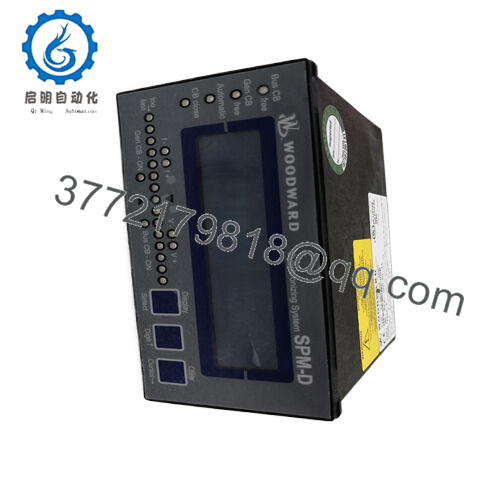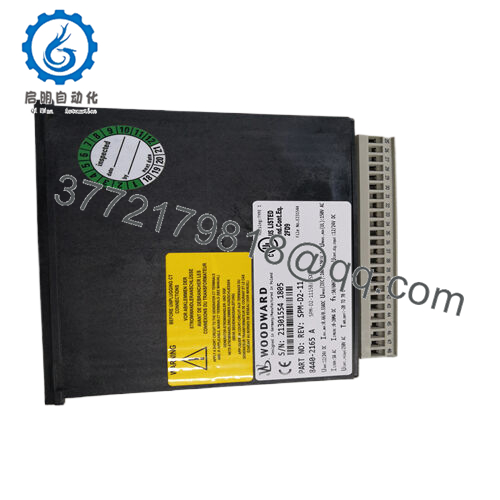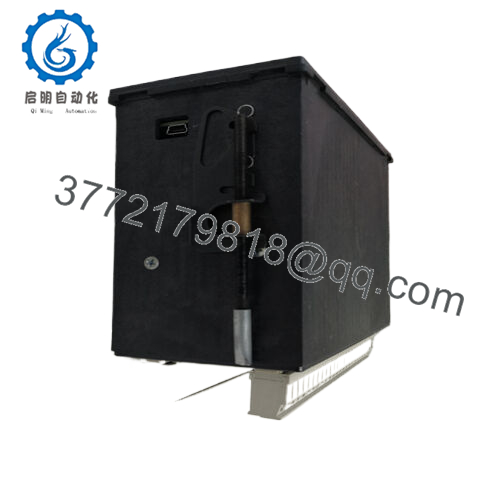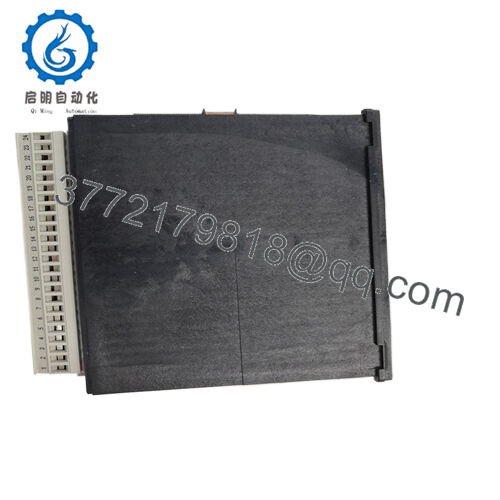Description
Product Model: 8440-2165
Product Brand: Woodward
Product Series: SPM-D2-11 (LSXR)
Product Features:
- Microprocessor-based synchronizer providing phase, frequency, and voltage matching plus active/reactive load sharing control
- Dual analog load share lines for kW/VAR sharing and support for power factor control
- True RMS voltage sensing (generator & bus), password protection, USB ToolKit configuration, drop-in replacement of SPM-D units
- Supply: 12/24 VDC (9.5–32 V), intrinsic consumption up to ~8 W; ambient range –20 °C to +70 °C
Applications & Industry Context
In modern power generation (whether fossil, hydro, or cogeneration), synchronizing generators to a common bus is fundamental—and the 8440-2165 SPM-D2-11 is tailor-made for that. When adding a generator to a live bus, you need frequency, phase, and voltage alignment before breaker closure. The SPM-D2-11 handles that automatic matching and then transitions into load sharing, power factor control, and protection within a single module.
You’ll often find this unit in standby genset systems, utility intertie setups, microgrid islands, and turbine installations where multiple machines must run in parallel. For example, in a co-generation plant, steam turbines and gas turbines may feed a shared bus. The SPM-D2-11 ensures smooth parallel operations, that real and reactive power are shared proportionally, and that transitions (load pickup, shedding) are controlled.
Because the SPM-D2 is a drop-in replacement for the older SPM-D family, many plants upgrade legacy synchronizers to regain support, newer features (USB, password protection), and improved diagnostics without full rewiring or rearchitecting.
Moreover, as renewable and distributed generation becomes more common, units like the SPM-D2-11 are central in microgrid control, enabling smooth transitions between grid-connected and islanded modes. Its capacity to handle active/reactive sharing, breaker logic, and synchronism gives engineers flexibility to manage complex generator fleets.
In real-world projects, control engineers appreciate that the 8440-2165 unifies multiple functions—synchronizer, load share, protection—into one compact device, reducing panel space, wiring, and configuration overhead.
Product Role & System Fit
The 8440-2165 SPM-D2-11 is primarily a synchronizer and load share controller in generator systems. Its job is twofold:
- Synchronize — match generator voltage, phase, and frequency to the bus before breaker closure
- Load & Reactive Share / Control — once paralleled, distribute active (kW) and reactive (VAR) power proportionally across units
It also includes generator protection logic (over/under voltage, over/under frequency, overload, etc.). The SPM-D2-11 works with both discrete (raise/lower) bias outputs and analog bias (voltage or current) control signals for speed control or AVR control.
In an installation, you’ll see the SPM-D2-11 mounted in a control cabinet with connections to:
- Generator voltage sensing (L1, L2)
- Bus voltage sensing
- Current transformer (CT) inputs for load measurement
- Discrete inputs (mode selection, permissives, breaker feedback)
- Relay outputs for breaker commands and alarms
- Bias outputs to governor (speed) and/or AVR (voltage)
- Auxiliary 12/24 V DC supply, configuration interface (USB)
Because the D2 series is designed to mimic the layout and behavior of the older SPM-D, it can be a drop-in swap in many legacy systems.
Its role within a multi-unit system is critical: after synchronization, the SPM-D2-11 takes over load control logic and interacts with other units’ SPM-D2 modules via load share lines (kW and VAR). From there, the speed control (governor) and excitation (AVR) follow bias signals from the module.
Thus, the 8440-2165 is both a command and coordination hub—it ensures each generator contributes properly and that system stability is maintained.
- 8440-2165 SPM-D2-11
Technical Features & Benefits
Let’s explore what makes 8440-2165 (SPM-D2-11) stand out, and where engineers see real gains.
Phase / Frequency / Voltage Matching
It supports phase match (zero phase difference) or slip frequency modes, as well as voltage matching before breaker closure. This ensures safer, smoother synchronization. The module measures both generator and bus voltages using true RMS sensing (class I accuracy) to reduce harmonic effects.
Active & Reactive Load Sharing / Control
Once in parallel, two analog load share lines enable the 8440-2165 to manage both real power (kW) and reactive power (VAR) sharing among units. It also supports power factor control (maintaining PF setpoints) when in grid-connected operation.
Soft Unloading & Power Limiting
This model supports soft unloading (gradual reduction of load before shutdown) and power limiting functions with dedicated relay outputs, helping protect units from abrupt changes.
Flexible Output Signals
Control outputs are configurable: the D2-11 can use discrete raise/lower signals, analog voltage/current bias outputs, or PWM signals depending on your control scheme. That flexibility allows integration with many types of governors or ARVs without extensive hardware changes.
Drop-In Replacement & Backward Compatibility
Woodward designed the SPM-D2 series to mimic SPM-D pinouts and mounting, making 8440-2165 a clean upgrade path from legacy units.That means less downtime and lower migration cost.
Modern Configuration & Protection
It includes a two-line LCD display for operational values, alarms, and status. It supports USB connectivity and ToolKit configuration software, making parameter setup or firmware changes easier. A multi-level password protection keeps unauthorized changes out.
On protection, it incorporates over/under voltage, over/under frequency, overload, reverse current detection, load faults, and more—integrated within one module.
Compact Power Supply & Low Consumption
Operates from 12/24 V DC (9.5 to 32 VDC) with intrinsic power consumption up to ~8 W. The modest power draw means it can run off existing control bus supplies without undue burden.
Robust Environmental Tolerance
Designed for industrial environments: operating ambient –20 °C to +70 °C, humidity up to 95% non-condensing. Its voltage input tolerances allow for 100/110 VAC or 230/400 VAC systems with good surge handling.
In the field, users have remarked that after upgrading to D2-11, synchronization is “snappier,” fewer synchronization faults occur, and load balance is better maintained under varying loads—especially during transient events.
Technical Specifications Table
| Parameter | Value / Description |
|---|---|
| Module Type | Load Share Synchronizer (SPM-D2-11 / LSXR) |
| Power Supply | 12/24 VDC (9.5 to 32 VDC) |
| Intrinsic Consumption | ≤ 8 W |
| Ambient Operating Temp | –20 °C to +70 °C |
| Humidity | 95% non-condensing |
| Voltage Sensing | Generator & bus, two-phase true RMS, Class I accuracy |
| Voltage Range | 63/110 VAC or 230/400 VAC (depending variant) |
| CT Input | Standard CT (e.g. …/5 A) for load measurement |
| Synchronization Modes | Phase match, slip frequency, voltage matching |
| Output Types | Discrete raise/lower, analog bias (voltage/current), PWM (selectable) |
| Analog Load Share Lines | Dual (kW and VAR share) |
| Display | Two-line LCD, operational values & alarms |
| Connectivity | USB interface for ToolKit configuration |
| Protection Functions | Over/under voltage, over/under frequency, overload, reverse current, etc. |
| Soft Unload / Power Limit | Supported with relay outputs |
| Weight / Dimensions | ~2 kg shipping weight; physical size ~4.7 × 3.7 × 1.3 in (approx) |
Installation & Maintenance Insights
Here are practical tips and caveats for installing, commissioning, and maintaining your 8440-2165 SPM-D2-11.
Mounting & Location
Mount within a clean, ventilated control cabinet, shielded from excessive vibration or heat. Leave room for front-panel access so you can see the LCD, LED, and synchronoscope. Avoid mounting adjacent to large power transformers or heavy switching gear that could induce electromagnetic interference.
Sensing Wiring
Voltage (generator & bus) wiring should be shielded, twisted, and matched. The sensing lines should refer to a common reference. Use the correct voltage transformer type (phase or delta) depending on system configuration. The SPM-D2 uses true RMS measurement, so ensure your wiring doesn’t introduce distortion.
For CT wiring, ensure proper polarity and that secondary returns reference the same ground scheme. Keep CT leads short and twisted. Ensure no saturation under overload conditions.
Power Wiring
Supply 12/24 V DC properly, with protection (fuse, overcurrent). The module’s intrinsic consumption (~8 W) is small but confirm upstream supply margin. Don’t share power wiring with heavy loads or high-noise circuits that could introduce disturbances.
Relay & Discrete Inputs
Wire the breaker command relay outputs to CB (close/open) circuits. Ensure that the relay ratings match the coil loads. Discrete inputs (mode selection, permissive signals) should be debounced and protected to avoid spurious logic toggling.
Commissioning & Configuration
- Power up the unit and verify LCD displays generator/bus volt/frequency
- With no load, test synchronization behavior in CHECK mode
- Adjust phase/dwell parameters to get stable synchronization
- Enable RUN mode and validate breaker close command under acceptable mismatch
- Add load gradually and monitor real/reactive sharing across units
- Exercise soft unload and power limit functions
- Monitor alarms and event logs; adjust tuning (gain, compensation) for stability
Maintenance & Diagnostics
- Periodically inspect terminals and wiring for corrosion
- Use USB connection with ToolKit for parameter backup and firmware updates
- Monitor LCD/alarm logs to catch issues before failures
- Confirm that load share lines remain healthy and balanced
- In high-duty systems, consider keeping a calibrated spare module ready
Because the D2-11 is digital, most diagnostics (voltage, currents, event history, registers) are visible via display or USB, making troubleshooting easier compared to older analog systems.
Spare Strategy & Firmware
Record your parameter set and firmware version. If a unit fails, having a preconfigured spare with matching firmware saves crucial time. When updating firmware or parameters, always bench-test before deploying to live systems.
Related Models & Alternatives
Here are some sibling or alternate modules you might encounter or consider:
- SPM-D2-10 — another variant in the D2 series (possibly different measurement or bias outputs)
- SPM-D (original series, e.g., SPM-D11 / D12) — older generation devices that D2 is designed to replace (drop-in compatibility)
- 8440-1705 / 8440-1706 — older SPM-D11 era units, still in circulation
- Standalone load sharing controllers or digital paralleling modules — for systems not using Woodward’s SPM line
- Integrated generator controllers with built-in synchronization / sharing — replacing discrete synchronizer modules altogether
When planning upgrades or retrofits, compare extra benefit from D2 (USB, protection, digital diagnostics) vs. migrating to all-in-one controller architectures.





 WhatsApp: +86 16626708626
WhatsApp: +86 16626708626 Email:
Email:  Phone: +86 16626708626
Phone: +86 16626708626


